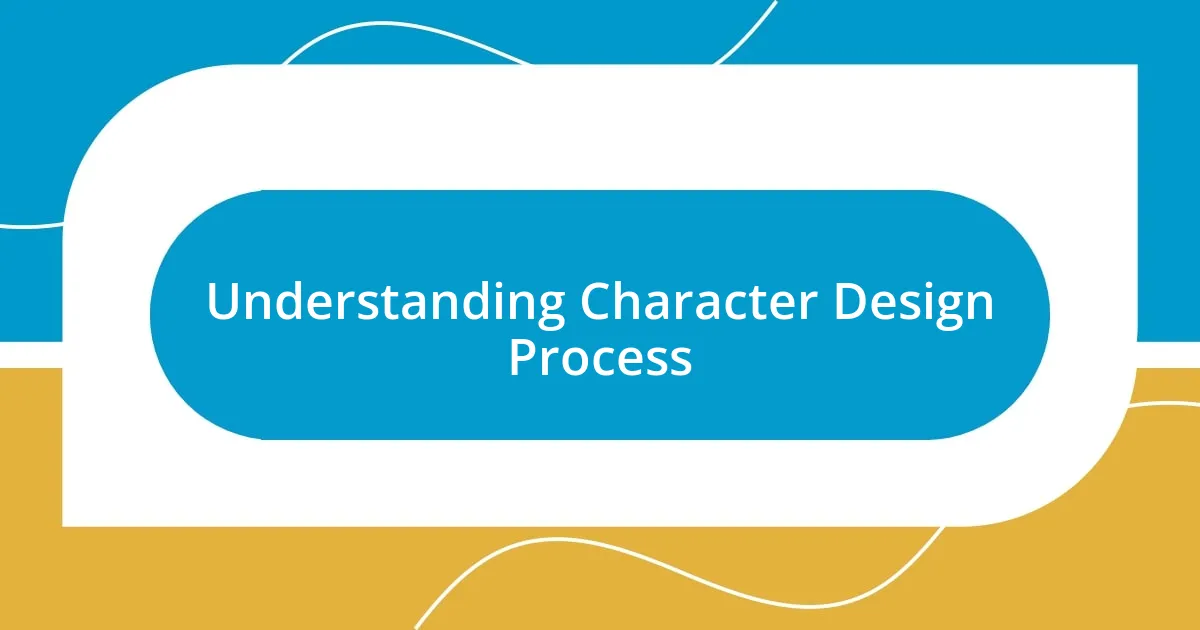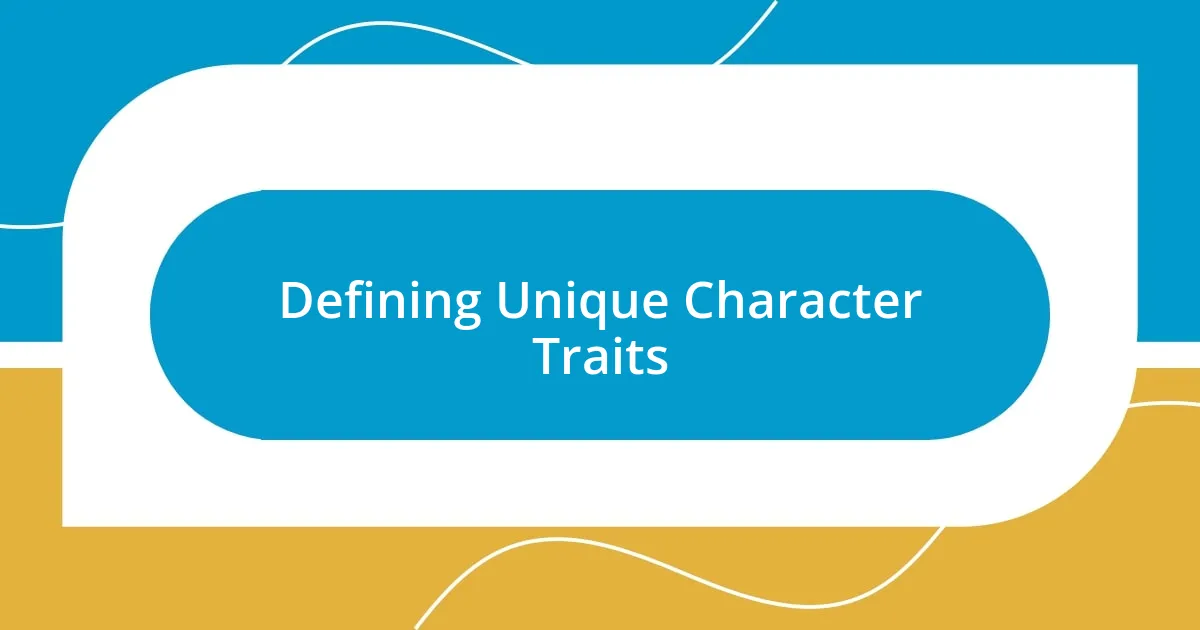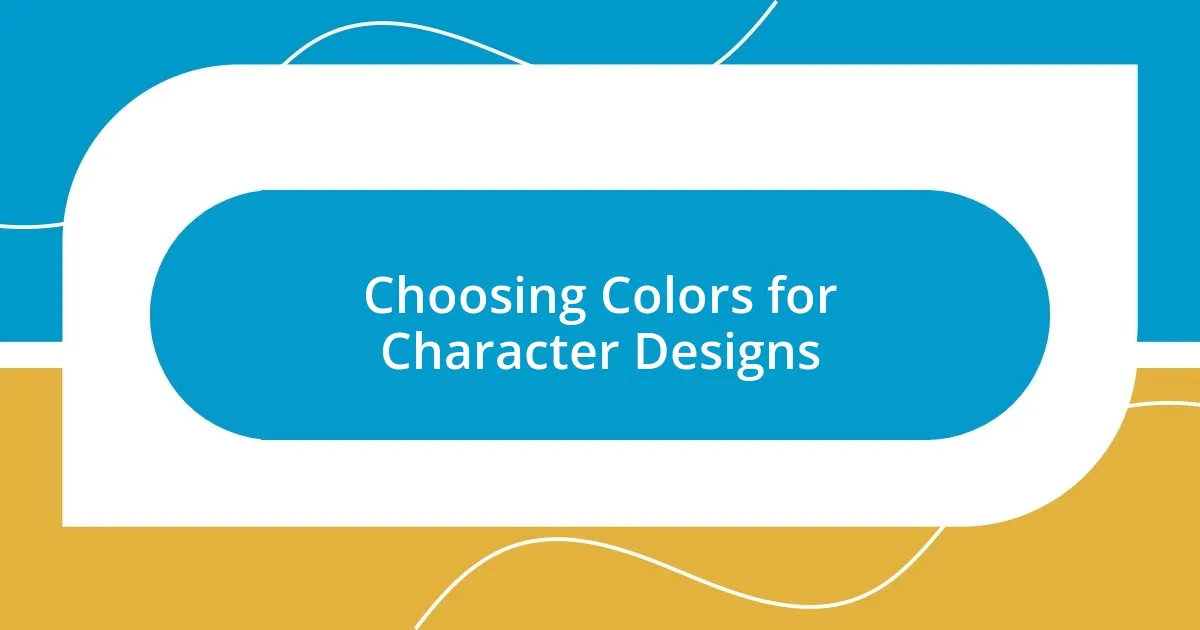Key takeaways:
- Character design involves understanding a character’s core identity, influences, and emotional layers, which shape their visual representation.
- Defining unique character traits and motivations enhances the narrative, allowing visual elements to reflect internal dynamics, such as contrasting traits creating depth.
- Feedback is crucial for refining character designs, offering new perspectives that can reshape design elements and emotional connections with the audience.
- Final touches in character design, including details like color palettes and physicality, play a significant role in how well characters resonate with and engage viewers.

Understanding Character Design Process
Character design is much more than sketching a figure; it’s about breathing life into your creation. I remember my first attempt at designing a character who was a fierce warrior. As I developed her backstory, I found myself pouring my emotions into every detail, from her scarred armor to the determination in her eyes. Have you ever noticed how a character’s story can influence their design elements? It’s a powerful connection that brings authenticity to the visual aspect.
When I approach character design, I always start by thinking about who the character is at their core. For example, while working on a vibrant, optimistic character, I focused on color choices and shapes that exuded warmth, like rounded edges and bright hues. This strategy not only defines the character’s personality visually but also engages the audience on an emotional level. How do these design choices resonate with you?
Another essential aspect of the character design process is iteration. I often find myself sketching multiple versions before landing on one that truly embodies my vision. Each iteration unlocks new details and reveals nuances I hadn’t considered before. It’s like peeling layers off an onion; each layer uncovers a deeper understanding of who the character is meant to be. Have you ever felt that thrill of discovery when refining your ideas?

Defining Unique Character Traits
Defining unique character traits is pivotal in crafting memorable characters. I often find that a single trait can define a character’s entire persona. For instance, I designed a quirky inventor whose eccentricity was encapsulated in her chaotic workshop—tools scattered everywhere, half-finished gadgets, and blueprints full of wild ideas. This visual clutter not only reflected her personality but also made her relatable to anyone with a creative spark. Isn’t it fascinating how a single aspect can tell so much?
When I brainstorm character traits, I like to ask myself, “What makes this character tick?” Identifying a character’s primary motivation helps shape the details around them. I remember creating a detective who was driven by a quest for justice; his serious demeanor naturally influenced a more muted color palette in his clothing. This choice not only highlighted his dedication but also created a strong contrast with the more flamboyant characters around him, enhancing his unique presence in the story. Have you seen how motivations can color a character’s attributes?
In my experience, pairing contrasting traits can lead to compelling dynamics. Take, for instance, a character that is both a nurturing parent and a ruthless businessperson; this duality can create tension and depth. In one of my stories, I introduced a seemingly sweet old woman who secretly ran a powerful underground network. The shock of her dual existence not only surprised the audience but also made them reevaluate their perception of her character. What unexpected traits have intrigued you in character designs?
| Character Trait | Description |
|---|---|
| Eccentricity | Reflects creativity through chaotic surroundings. |
| Motivation | Influences visual choices to enhance story elements. |
| Contrasting Traits | Creates depth and surprises within character arcs. |

Creating Dynamic Character Silhouettes
When it comes to creating dynamic character silhouettes, I’ve found that shape and proportion are key elements that breathe life into your designs. I once created a swashbuckling pirate whose silhouette was defined by sweeping curves and sharp angles. This visual dichotomy not only made her instantly recognizable but also echoed her adventurous spirit and unpredictable nature. Every time I sketch a character silhouette, I consider how the shapes can tell a story before a word is spoken.
To enhance a character’s silhouette, I focus on the following strategies:
- Use of Contrasting Elements: Combining broad shapes with slender ones creates visual variety that grabs attention.
- Emphasize Height and Width: Tall, narrow silhouettes can convey elegance or danger, while short, wide shapes can suggest stability or playfulness.
- Play with Details: Accessories, at varying scales, add interest without overwhelming the core shape. A large hat or oversized weapon can define a character’s personality in an instant.
In my design process, I often find that exaggerating a silhouette can reinforce a character’s essence. For example, I designed a timid fairy with a small, rounded silhouette but oversized, vibrant wings to symbolize her hidden potential. This approach not only made her visually intriguing but also mirrored her internal struggle, showcasing how shape can carry emotional weight.

Choosing Colors for Character Designs
Choosing the right colors for character designs can be a game-changer. I recall designing a fierce warrior whose vibrant red and gold palette not only represented her courage but also made her stand out in battle. It’s amazing how colors can evoke emotions and convey traits—what feelings arise when you see a character draped in deep blue or lively green?
I often advise experimenting with color combinations to find what truly brings a character to life. For instance, I designed a whimsical bard whose pastel hues and playful patterns echoed her lively personality. Watching how these choices transformed her from a simple idea into a colorful persona was incredibly rewarding. Have you noticed how certain colors just resonate with specific character traits?
Additionally, I believe understanding the basics of color theory can elevate your designs. I remember a project where I utilized complementary colors to create a stunning visual impact; the contrast between the fiery orange of the main character and the cool blue of her rival created a palpable tension. This contrast made their rivalry visually compelling and added depth to their interactions. Have you experimented with different color palettes, and how did they influence your character’s story?

Developing Backstories for Characters
When developing backstories for characters, I find that a detailed history can significantly deepen their resonance with the audience. Take, for instance, a character I designed—a former thief turned hero. I crafted her backstory around a traumatic childhood, where survival meant stealing to support her family. This choice not only shaped her moral compass but also added layers to her motivations and relationships. I often ask myself: how does a character’s past inform their decisions and shape their identity?
It’s fascinating how a well-crafted backstory can serve as a launching point for character arcs. I remember designing a character who was once a celebrated artist but fell from grace due to a scandal. This fall from grace provided a rich ground for exploring themes of redemption and self-discovery. I love to think about how the past can haunt or empower—what kind of emotional weights do your characters carry from their histories?
An effective strategy I use involves weaving personal struggles into the fabric of a character’s backstory. For example, I created a cheerful mentor whose outward positivity was a facade hiding a painful loss. By incorporating this complexity, I could engage with my audience on a deeper emotional level, inviting them to empathize with her journey. What about your characters—how do their histories shape their present realities, and how do you convey that transformation through their stories?

Testing Character Designs through Feedback
Receiving feedback on character designs is a vital step that can elevate your work in ways you might not initially expect. I remember sharing a character concept with a group of fellow artists, and their insights led me to reconsider certain design elements that I thought were fixed. Just hearing how others perceived my character helped me realize that subtle details, like costume intricate patterns or even a character’s posture, can resonate differently with various audiences. Have you ever had a moment where a simple suggestion completely transformed your design?
In my experience, feedback sessions can spark inspiration that fuels creativity. One time, I held a small online critique of a character I designed for a fantasy novel. A participant pointed out that incorporating more asymmetry in her armor could enhance her fierce demeanor, and after making the adjustment, the character felt so much bolder. It’s remarkable how outside perspectives can shine a light on the aspects we might overlook—how do you create a space where constructive criticism flourishes?
I also find that engaging with the audience directly adds another layer to character feedback. When I showcased my designs at a convention, I encouraged attendees to share their thoughts on which characters resonated with them and why. One attendee described how a character’s bright, mismatched clothing reminded them of a loved one, prompting me to tap into those emotional connections in my storytelling. Isn’t it fascinating how characters can evoke personal memories in others? Embracing feedback not only shapes better designs but also deepens the emotional impact of our creations.

Refining Characters for Final Presentation
Refining character designs for final presentation is where the magic truly happens. I often find myself delving into the smallest details to ensure each character feels alive and relatable. For instance, a character I presented once had a particularly intricate necklace I had originally dismissed as just detailing. However, upon further reflection, I realized it could symbolize her journey—a keepsake from her mother that connected her to her past, enhancing both her visual design and narrative significance. Isn’t it invigorating how a single detail can alter a character’s impact?
Color palettes also play a crucial role in refinement. I vividly recall a character whose initial color scheme was vibrant and bold, but it felt off to me in the context of her story—a darker narrative about loss and betrayal. By toning down the colors and opting for deeper, muted shades, I could better reflect her internal struggles. Have you ever altered a character’s colors and felt an immediate shift in their story depth? It’s fascinating how visuals can speak volumes about a character’s emotional landscape.
In my own process, I take the time to revisit a character’s expression and posture as part of my final touches. I remember adjusting the stance of a character who was meant to be fiercely independent yet vulnerable. By shifting her posture to be slightly more open with a subtle tilt of her head, I was able to convey both strength and a hint of uncertainty. Through this, the audience could connect with her on a more profound level. How do you capture the essence of your characters through their physicality? Each refinement step is a chance to engage the audience further and convey the depth of character—an opportunity I never take lightly.














